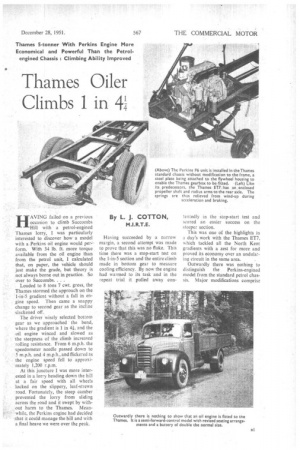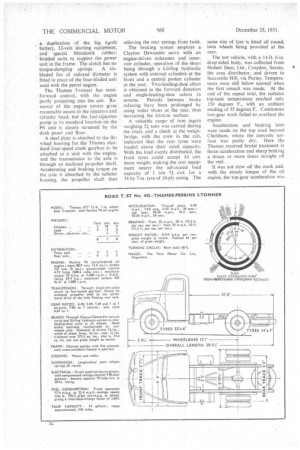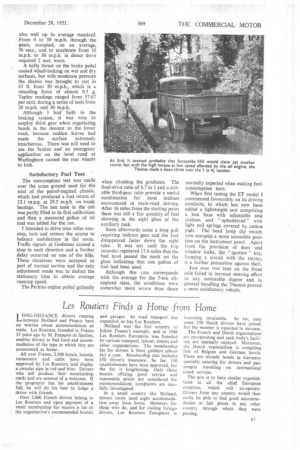Thames Oiler
Page 35

Page 36

Page 37

If you've noticed an error in this article please click here to report it so we can fix it.
Climbs 1_ in 4[4 By 1. J. COTTON, M.i.R.T.E. • HAVING failed on a previous —Occasion to climb Succombs
• Hill with a petrol-engined Thames lorry, I was particularly interested to discover how a model with a Perkins oil engine would per-' form. With 34 lb. ft. more torque available from the oil engine than from the petrol unit, I calculated . that, on paper, the vehicle should just Make the grade, but theory is not always borne out in practice. So over to Suecombs. . . .
Loaded to 8 tons .7 cwt. gross, the
• Thames stormed the approach on the
• .1-in-5 . gradient .without a fall in engine speed. Then came a snappy change to second gear as the incline siackened off.
The driver wisely selected bottom gear as we approached • the bend, where the gradient is 1 in 41, and the oil engine winced and slowed as the steepness of the .climb increased rolling resistance. From 6 m.p.h. the .speedometer needle passed down to .5 m.p.h. and 4 m.p.h., and flickered as
• the engine 'speed fell to approximately 1,200 r.p.m.
At this juncture I was more interested in a. lorry heading down the hill at a fair speed with all, wheels
• locked on the slippery, leaf-strewn road. Fortunately, the steep camber prevented the lorry from sliding . across the road and it swept by without harm to the Thames. Meanwhile, the Perkins engine had decided .,that it could manage the hill and with a final heave we were over the peak. Having succeeded by a narrow margin, a second attempt was made to prove that this was no fluke. This time there was a stop-start test on the I-in-5 section and the entire climb made in bottom gear to measure cooling efficiency. By now the engine had warmed to its task and in the repeat trial it pulled away con
tentedly in the stop-start . test and scored an easier success on the steeper section.
This was one of the highlights in a day's work with the Thames ET7, which tackled all the North Kent gradients with a zest for more and proved its economy over an undulating circuit in the same area.
Outwardly there was nothing to distinguish the Perkins-engined model from'the standard petrol chassis. Major modifications comprise a duplication of the big 6,olt battery, 12-volt starting equipment, and special Metalastik rubber'• bonded units to support the power unit in the frame: The clutch has no torque-damping springs. A sixbladed fan of reduced diameter is fitted in place of the four-bladed unit used with the petrol engine.
The Thames 5-tonner has semiforward control, with the engine partly projecting into the cab. Removal of the engine covers gives reasonable access to the injectors and cylinder head, but the fuel-injection pump in its standard location on the P6 unit is closely screened by the dash panel and floor.
A steel plate is attached to the flywheel housing for the Thames standard four-speed crash gearbox to be attached as a unit with the engine, and the transmission to the axle is through an enclosed propeller shaft. Accelerating and braking torque on the axle is absorbed by the tubular housing. -the propeller shaft thus relieving the rear springs from twist.
The braking system employs a. Clayton Dewandre servo with an engine-driven exhauster and reservoir cylinder, operation of the shoes being through a Girling hydraulic system with external cylinders at the front and a central pusher cylinder at the rear. Two-leading-shoe effect is obtained in the forward direction and single-leading-shoe action in reverse. Periods between brake refacing have been prolonged by using wider shoes at the rear, thus increasing the friction surface.
A valuable cargo of iron ingots weighing 51 tons was carried during the trials, and a check at the weighbridge, with the crew in the cab, indicated that the rear tyres were loaded above their rated capacity. With the load evenly distributed, the front tyres could accept 14 cwt. more weight, making the rear equipment nearer the advocated load capacity of 1 ton 7i cwt. for a 34 by 7-in. tyre of 10-ply rating. The
same size of tyre is fitted all round, twin wheels being provided at the rear.
The test vehicle, with a I4-ft. 6-in. drop-sided body, was collected from Hubert Dees, Ltd., Croydon, Surrey, the area distributor, and driven to Succombs Hill, via Purley. Temperatures were still below normal when the first assault was made. At the end of the repeat trial, the radiator top-tank temperature reached only 150 degrees F., with an ambient reading of 55 degrees F. Continuous low-gear work failed to overheat the engine.
Acceleration and braking tests were made on the top road beyond Chelsham, where the concrete surface was partly dry. Here the Thames received brutal treatment in fierce acceleration and sharp braking a dozen or more times straight oft the reel.
It was not slow off the mark and. with the steady torque of the oil engine, the top-gear acceleration was also well up fo average standard. From 0 to 30 m.p.h. through the gears, occupied, on an average, 36 secs., and to accelerate from 10 m.p.h. to 30 m.p.h. in direct drive required 2 secs. more.
A hefty thrust on the brake pedal caused wheel-locking on wet and dry surfaces, but with moderate pressure the chassis was brought to rest in 63 ft. from 30 m.p.h., which is a retarding force of almost 0.5 g. Tapley readings ranged from 57-67 per cent. during a series of tests from 20 m.p.h. and 30 m.p.h.
Although I had faith in the braking system, it was wise to employ third gear when negotiating bends in the descent to the lower road, because sodden leaves had made the surface extremely treacherous. There was still need to use the brakes and an emergency application on the level road at Warlingham caused the rear wheels to lock.
Satisfactory Fuel Test
The consumption test was made over the same ground used for the trial of the petrol-engined chassis, which had produced a fuel return of 12.1 m.p.g. at 29.3 m.p.h. on trunk haulage. The test tank in the cab was partly filled to its first calibration and then a measured gallon of oil fuel was added for the run.
I intended to drive nine miles nonstop, turn and retrace the course to balance undulations in the MAO. Traffic signals at Godstone caused a stop in each direction and a further delay occurred on one of the hills. These situations were accepted as part of normal service and the only adjustment made was to deduct the stationary time to obtain average running speed.
The Perkins engine pulled gallantly when climbing the gradients. The final-drive ratio of 6.7 to 1 and a suitable third-tear ratio provide a useful combination for most inclines encountered in main-road driving. After 16 miles from the starting point there was still a fair quantity of fuel showing in the sight glass of the auxiliary tank.
Soon afterwards came a long pull requiring indirect gear and the fuel disappeared faster down the sight tube. It was not until the trip recorder registered 17.4 miles that the fuel level passed the mark on the glass indicating that one gallon of fuel had been used.
Although this rate corresponds with the average for the 5-ton oilengined class, the conditions were somewhat more severe than those normally expected when making fuelconsumption tests.
When first testing the ET model I commented favourably on its driving comforts, to which has now been added a lightweight seat comprising a box base with adjustable seat cushion and " upholstered " with light coil springs covered by cotton pai)s. The head lamp dip switch now occupies a more accessible position on the instrument panel. Apart from the provision of door and window locks, the "ignition '' key, forming a circuit with the starter, is a further precaution against theft.
Just over two tons on the front axle failed to increase steering effort to any noticeable degree and in general handling the Thames proved a most satisfactory vehicle.












































































